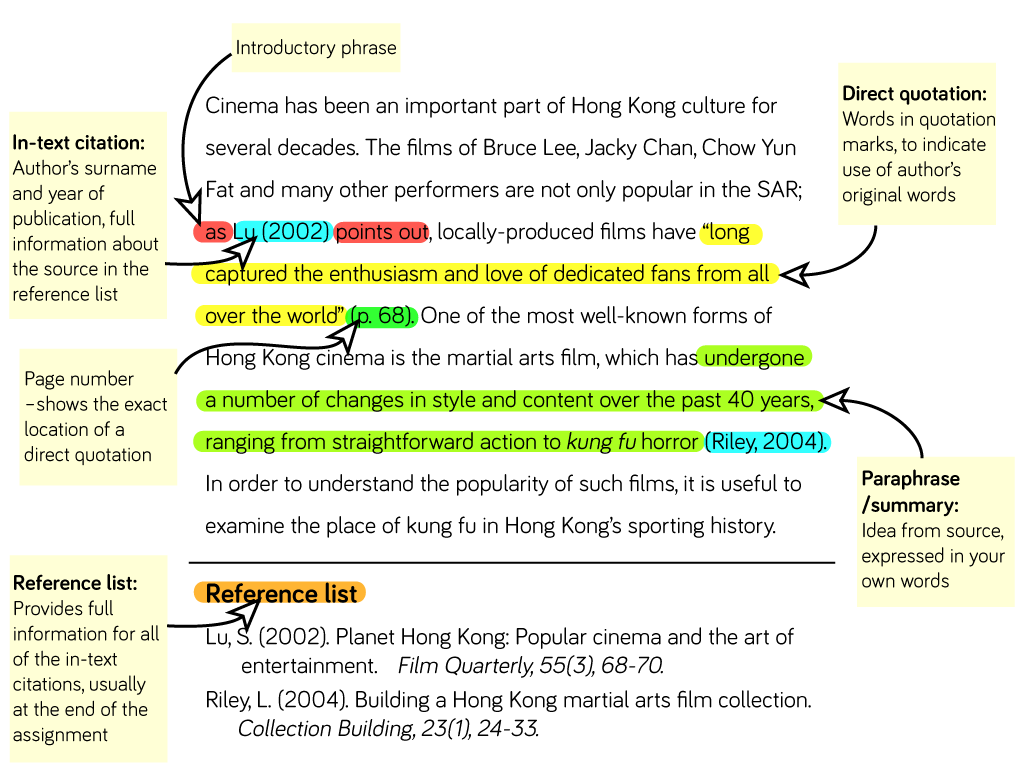Citing & Referencing
Shing and Teresa are students at CityU. In the conversation below they are discussing movies.
- Teresa:
- Shing, have you seen The Avengers?
- Shing:
- No, I don’t think I want to.
- Teresa:
- Really? Why not?
- Shing:
- I don’t like action movies. Also, Xiao saw it on Thursday and he said it’s very long and a bit boring.
- Teresa:
- But Xiao doesn’t know anything about movies! Ying told me it’s a great film!
In this conversation, Shing gives Teresa two reasons for not wanting to see the film:
- He doesn’t like action movies (Shing’s own thought)
- Xiao says the film is poor (Shing uses Xiao as a source of additional ideas & information)
Teresa shows that:
- She doesn’t trust Xiao’s ideas
- She has more trust in Ying’s ideas
So, the ideas of four different people are involved in this conversation.
When you are given writing assignments at the University, you will usually need to include the ideas of others in your writing, and to show clearly that you are doing so. You do this by using the techniques of citation and referencing.
Why cite and reference sources?
The main reasons that you should cite and reference the work of others in academic writing are:
- To give credit to another author for his/her idea
- To show that you have researched your topic and you understand the concepts and know who has written about them
- To allow your reader to find and examine your sources
So, by citing and referencing sources you not only acknowledge the work of others in your assignment, you also demonstrate that you are becoming part of the ‘academic conversation’.
How do I cite and reference sources?
Read the following paragraph (click it to enlarge) from an academic text and look at the ways in which the author incorporates information from sources (using APA style).

In-text citations
You need to include an in-text citation (see the example above) whenever:
- You use the original ideas of others by quoting their exact words
- You use the original ideas of others by paraphrasing or summarizing their words
Note that if an idea is ‘common knowledge’, it is not necessary to cite the source. However, it is sometimes hard to tell for sure that an idea is ‘common knowledge’. Remember the golden rule: If in doubt, cite the source!
Important: If you don’t include proper in-text citations, it is considered plagiarism.
The reference list
If you cite a work in your text, you must include a full reference to that work in a reference list at the end of your assignment (see the example above). The reference list provides the information that is needed by a reader who wishes to locate the text that you have cited.
Important: If you don’t include a proper reference list, it is considered plagiarism.
Citation and referencing styles
Scholars from different disciplines have different expectations about citation and referencing style. For example, scientists use a different style when compared to that of lawyers.
We recommend that you ask your teachers which style they expect you to use.
A number of common styles are listed below, with links to related style guides:
- APA (commonly used in Social Sciences)
- CSE (commonly used in Natural and Applied Sciences)
- Chicago (commonly used in Natural and Social Sciences)
- IEEE (commonly used in Engineering)
- MLA (commonly used in Humanities)
- Harvard (commonly used in Social Sciences)
- OSCOLA (commonly used in Law)
How do I cite the content obtained from Generative AI (GenAI) Tools?
GenAI tools may be a convenient means to assist your learning if you use ‘prompt engineering’ skillfully. Yet, you need to be cautious of the reliability of the information obtained and its usage. You should always verify the content before using the information.
If you are allowed to use GenAI tools in the assessment tasks, you must properly acknowledge the use and provide an explanation of why the piece of response from the GenAI tool is adopted. A suggested style guide on how to cite the use of GenAI tools is listed below:
Caulfield, J. (2023, May 15). ChatGPT Citations | Formats & Examples. Scribbr. Retrieved 1 June 2023, from https://www.scribbr.co.uk/using-ai-tools/chatgpt-references/
Important: If you don’t cite the GenAI properly when you are allowed to use it for an assessment task, it is considered plagiarism.
More information
You can learn more about citation and referencing by going to the CityU Library Citing Sources of Information Research Guide or taking part in Information Skills Workshops.